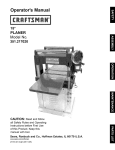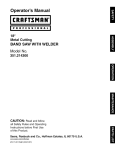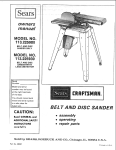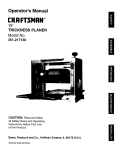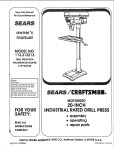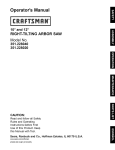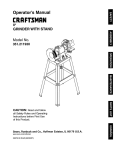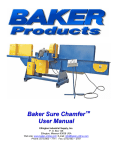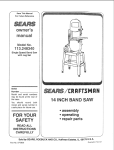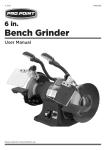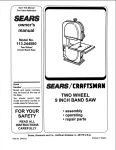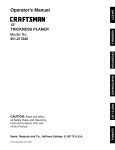Download Craftsman 351.217040 Operator`s manual
Transcript
Operator's
Manual
20"
PLANER
Model No.
351.21 7040
CAUTION:
Read and follow
all Safety Rules and Operating
Instructions before First Use
of this Product. Keep this
manual with tool.
Sears, Roebuck and Co., Hoffman
www.sears.com/craftsman
22589.00 Draft (02/07/05)
Estates, IL 60179 U.S.A.
•
Warranty
....................................
SafetyRules...............................
Unpacking..................................
Assembly.................................
Installation
.................................
KnowYourPlaner.............................
Operation................................
Maintenance
.............................
Troubleshooting
.............................
PartsIllustration
andList ...................
2
2-3
3
3-4
4-5
6
6-11
11-14
15
18-23
Be alert and think clearly. Never operate power tools
when tired, intoxicated or when taking medications
that cause drowsiness.
PREPARE
WORK
AREA FOR JOB
•
Keep work area clean. Cluttered work areas invite
accidents.
•
Do not use power tools in dangerous environments.
•
Do not use power tools in damp or wet locations. Do
not expose power tools to rain.
•
Work area should be properly lighted.
•
Proper electrical receptacle should be available for
tool. Three prong plug should be plugged directly
into properly grounded, three-prong receptacle.
•
Extension cords should have a grounding prong and
the three wires of the extension cord should be of
the correct gauge.
FULL ONE YEAR WARRANTY
•
Keep visitors at a safe distance from work area.
If this product fails due to a defect in material or workmanship within one year from the date of purchase, Sears will
at its option repair or replace it free of charge. Contact
your nearest Sears Service Center (1-800-4-MY-HOME)
to arrange for product repair, or return this product to
place of purchase for replacement.
•
Keep children out of workplace. Make workshop childproof. Use padlocks, master switches or remove switch
keys to prevent any unintentional use of power tools.
•
Always unplug tool prior to inspection.
If this product is used for commercial or rental purposes, this warranty will apply for 90 days from the date of
purchase.
•
Consult manual for specific maintaining and adjusting procedures.
•
Keep tool lubricated and clean for safest operation.
This warranty applies only while this product is used in
the United States.
•
Remove adjusting tools. Form habit of checking to
see that adjusting tools are removed before switching machine on.
•
Keep all parts in working order. Check to determine
that the guard or other parts will operate properly
and perform their intended function.
•
Check for damaged parts. Check for alignment of
moving parts, binding, breakage, mounting and any
other condition that may affect a tool's operation.
•
A guard or other part that is damaged should be
properly repaired or replaced. Do not perform
makeshift repairs. (Use parts list provided to order
replacement parts.)
TOOL SHOULD
This warranty gives you specific legal rights, and you
may also have other rights which vary from state to state.
Sears, Roebuck and Co., Dept. 817WA, Hoffman
Estates, IL 60179
WARNING:
For your own safety, read all of the rules
and precautions before operating tool.
CAUTION: Always follow proper operating procedures
as defined in this manual even if you are familiar with
use of this or similar tools. Remember that being careless for even a fraction of a second can result in severe
KNOW HOW TO USE TOOL
personal injury.
BE PREPARED
BE MAINTAINED
FOR JOB
•
Use right tool for job. Do not force tool or attachment
to do a job for which it was not designed.
•
Disconnect tool when changing blades.
•
Avoid accidental start-up. Make sure that the switch
key is in the OFF position before plugging in.
•
Do not force tool. It will work most efficiently at the
rate for which it was designed.
•
Wear proper apparel. Do not wear loose clothing,
gloves, neckties, rings, bracelets or other jewelry
which may get caught in moving parts of machine.
•
Wear protective hair covering to contain long hair.
•
Wear safety shoes with non-slip soles.
•
•
Wear safety glasses complying with United States
ANSI Z87.1. Everyday glasses have only impact
resistant lenses. They are NOT safety glasses.
Keep hands away from moving parts and cutting
surfaces.
•
Never leave tool running unattended. Turn the power
off and do not leave tool until it comes to a complete
stop.
•
Do not overreach. Keep proper footing and balance.
•
Wear face mask or dust mask if operation is dusty.
© Sears, Roebuck and Co.
2
•
Never stand on tool. Serious injury could occur if tool is
tipped or if blade is unintentionally contacted.
•
Know your tool. Learn the tool's operation, application and specific limitations.
•
Use recommended accessories (refer to page 19).
Use of improper accessories may cause risk of
injury to persons.
•
Handle workpiece correctly. Protect hands from possible injury.
•
Turn machine off if it jams. Blade jams when it digs
too deeply into workpiece. (Motor force keeps it
stuck in the work.)
Always keep drive, cutterhead and blade guards in
place and in proper operating condition.
•
•
WARNING:
Do not attempt assembly if parts are
missing. Use this manual to order replacement parts.
PLANER
Before planer is assembled, a suitable location should
be chosen. The planer weighs approximately 800 Ibs
when completely assembled. Planer should be assembled on location.
•
Planer needs to be set on a flat, level surface. This
improves stability, accuracy and prevents warpage
and failure of cast components and welds.
•
Make sure there is ample room on both infeed and
outfeed sides of planer for moving the workpiece
through the entire cut. There must be enough room
that neither the operators nor the bystanders will
have to stand in line with the wood while using the
tool.
•
Good lighting and correct power supply (230 volts)
are also required for a proper work area.
•
Place planer in its designated spot. Covers for
access to motor are on both front and rear sides of
Feed work into blade or cutter against direction of
rotation.
CAUTION: Think safety! Safety is a combination of
operator common sense and alertness at all times
when tool is being used.
WARNING:
Do not attempt to operate tool until it is
completely assembled according to the instructions.
stand. The planer is supplied with four lifting handles
that slide into the base on the infeed and outfeed
sides. The planer must be lifted by these handles
only and moved to the required location.
Check for shipping damage. If damage has occurred, a
claim must be filed with carrier. Check for completeness. Immediately report missing parts to dealer.
Additional parts which need to be fastened to the planer
should be located and accounted for before assembling.
INSTALLATION
•
Planer is shipped assembled except for the following:
two table extensions, handwheel handle, chip chute, two
roller gauge blocks, blade height gauge and hardware
bag.
With planer in position, check table surface lengthwise and crosswise with machinist level. Place metal
shims under low corners. Check that all four corners
are supported. Check table level in both directions
and secure machine to floor with lag bolts (not supplied) through plates at front and rear of stand.
Hardware bag (Part No. 23402.00) includes:
ATTACH SWITCH
•
•
•
•
•
Refer to Figure 1.
10-1.5 x 25mm Socket Head Bolt (8)
6-1.0 x 12mm Socket Head Bolt (8)
6mm Flat Washer (8)
10mm Flat Washer (8)
10mm Lock Washer (8)
•
BOX
Attach switch box to rollercase using two 6-1.0 x
12mm socket head bolts.
IMPORTANT: Table, table rollers and cutterhead are
coated with a protectant. To ensure proper fit and operation, remove coating. Coating is easily removed with
mild solvents, such as mineral spirits, and a soft cloth.
Use caution when cleaning the cutterhead, as the
blades are very sharp. Avoid getting solution on paint or
any of the rubber or plastic parts. Solvents may deteriorate these finishes. Use soap and water on paint, plastic or rubber components. After cleaning, cover all
exposed surfaces with a light coating of oil. Paste wax
is recommended for table top.
WARNING:
Never use highly volatile solvents. Nonflammable solvents are recommended to avoid possible
fire hazard.
Figure 1 - Installing Switch Box
MOUNT HEIGHT ADJUSTMENT
HANDWHEEL
HANDLE
Refer to Figure 21, page 20.
POWER
•
•
Required parts: Handle
Thread handle into handwheel.
WARNING:
Do not connect planer to the power
source until all assembly steps have been completed.
•
Tighten hex nut (Key No. 16) to secure handle.
The motor is designed for operation on the voltage and
frequency specified. Normal loads will be handled safely on voltages not more than 10% above or below specified voltage. Running the unit on voltages which are not
within range may cause overheating and motor burnout.
Heavy loads require that voltage at motor terminals be
no less than the voltage specified on nameplate.
MOUNT
CHIP CHUTE
Refer to Figure 21, page 20.
•
Required parts and hardware:
Chip Chute
6-1.0 x 12mm Hex Head Bolt (6)
6mm Flat Washer (6)
•
Position chip chute on chipbreaker cover (Key No. 54)
so that the slots on chip chute and chipbreaker cover
are aligned and slots on chip chute and holes on the
roller case are aligned.
•
Secure chip chute to chipbreaker cover using three
hex head bolts and three flat washers.
•
Secure chip chute to roller case (Key No. 1) using
three socket head bolts and three flat washers.
SOURCE
GROUNDING
INSTRUCTIONS
WARNING:
Improper connection of equipment
grounding conductor can result in the risk of electrical
shock. Equipment should be grounded while in use to
protect operator from electrical shock.
Check with a qualified electrician if grounding instructions are not understood or if in doubt as to whether the
tool is properly grounded.
This tool is equipped with an approved 3-conductor
cord rated up to 250V for your protection against shock
hazards.
MOUNT TABLE EXTENSIONS
Refer to Figure 2.
•
Required hardware:
10-1.5 x 25mm Socket Head Bolt (8)
10mm Flat Washer (8)
10mm Lock Washer (8)
Do not remove or alter grounding conductor in any
manner. In the event of a malfunction or breakdown,
grounding provides a path of least resistance for electrical shock.
•
Mount table extension to planer table on the infeed
side using four 10-1.5 x 25mm socket head bolts, flat
washers and lock washers. Do not tighten bolts completely.
Inspect tool cords periodically, and if damaged, have
repaired by an authorized service facility.
•
Place long straight edge across table and table
extension.
•
Use mallet to tap extension table flush with table.
•
Adjust set screws and socket head bolts (located at
outside edge of table extension) so that the table
extension is at the same height and angle as the table.
•
Tighten bolts to secure extension.
•
Repeat above steps for the outfeed extension.
Green (or green and yellow) conductor in cord is the
grounding wire. If repair or replacement of the electric
cord or plug is necessary, do not connect the green (or
green and yellow) wire to a live terminal.
WARNING: This work should be performed by a
qualified electrician.
EXTENSION
•
•
•
/
CORDS
The use of any extension cord will cause some drop
in voltage and loss of power.
Wires of the extension cord must be of sufficient size
to carry the current and maintain adequate voltage.
Use the table to determine the minimum wire size
(A.W.G.) extension cord.
•
Use only 3-wire extension cords having 3-prong
grounding type plugs and 3-pole receptacles.
•
If the extension cord is worn, cut, or damaged in any
way, replace it immediately.
EXTENSION CORD LENGTH
Wire Size
A.W.G.
Up to 50 ft ..................................
NOTE: Using extension cords over 50 ft. long is not
recommended.
Adjustment Set Screw
Figure 2 - Mount Table Extensions
Adjustment
Socket Head Bolt
4
12
MOTOR
The planer is assembled with motor and wiring
installed. The 230 Volt AC capacitor start motor has the
following specifications:
Install an approved plug onto the line cord. Connect to
a matching outlet that has been properly installed and
grounded in accordance with all local codes and ordinances.
Horsepower .................................
•
3
Voltage ...................................
230
Amperes .................................
Hertz .....................................
16.5
60
Phase ..................................
RPM ....................................
ELECTRICAL
Single
3450
CONNECTIONS
Refer to Figure 3.
WARNING:
All electrical connections must be performed by a qualified electrician. Make sure unit is off
and disconnected from power source while motor is
mounted, connected, reconnected or anytime wiring is
inspected.
Planer has an approved 230 volt three-conductor line
cord and a 230 volt magnetic contactor that is prewired
in the factory (See Figure 3).
230 Line Voltage
The tool has a key lock switch to prevent unauthorized use. Turn key lock switch to OFF and remove
key when tool is not in use.
NOTE: The motor will not start if the key is in the OFF
position
•
Connect planer to a supply circuit protected by a 30
AMP circuit breaker or time delay fuse.
OVERLOAD
PROTECTION
The magnetic contactor has overload protection that
helps to prevent damage to the motor. The overload
protection will automatically turn off the magnetic contactor when an overload occurs. Set thermal overload to
22 Amps. Be sure to disconnect planer from power
source when resetting overload protector. The protection is reset by opening the contactor box and pressing
the reset button.
CHECK
CONNECTIONS
Refer to Figure 4.
•
Plug in the line cord to a 230 volt power source.
•
Turn the key to ON.
•
Depress the start button. The motor must rotate
counterclockwise facing shaft end.
•
Depress the stop button. The motor must stop.
•
Depressing the start button with either the stop
button pressed down or the key in OFF position
must not start the motor.
•
If any of the above steps do not work properly, disconnect planer from power source and recheck the
connections.
To Motor
Figure 3 - Magnetic Contactor Wiring Schematic
Figure 4 - Power Controls
13
14
/
12
/
lO
!
4
\
7
1 Switch Box
2 Column
8 Table Locking Knobs
9 Thickness Scale
3 Table Rollers
10 Feed Rate Shift Handle
4 Extension Table
5 Base
6 Stand
11 Gearbox
12 Handwheel
13 Dust Collection Port
7 Lifting Handle
14 Return Rollers
SPECIFICATIONS
DESCRIPTION
Table Size .............................
20 x 26"
Table with Extensions ....................
20 x 56"
Blade Width ...............................
Refer to Figures 5-13, and 21.
Craftsman 20" Planer is a heavy duty cast iron unit that
can plane lumber up to 20" wide and 8" thick. Planer
has a 3.15" diameter, 4-blade cutterhead with jack
screws for easy blade adjustment and replacement.
Cutterhead and feed rollers travel on precision ground
steel columns. Lumber can be fed at 16 or 25 feet per
minute and can be cut up to 0.23" deep per pass.
Cuts per Minute ..........................
Planer comes with totally enclosed welded plate steel
cabinet, 4" port for dust collection and safety electrical
control with magnetic contactor. Includes 3 HP motor.
Weight ................................
Maximum Cut ........................
Floor Space ...........................
Dust collection port ...................
Motor ..........................
Overall Dimensions (D x W x H)........
6
20"
20,000
0.23" Deep
40 x 56"
4" Diameter
3 HE 3450 RPM
51 x 40 x 39"
750 Ibs
Planing refers to the sizing of lumber to a desired thickness while creating a level surface parallel to the opposite size of the board. Depth of cut is the term used to
indicate how deep the blades will cut into the workpiece.
OPERATION
SAFETY
RULES
WARNING: Operation of any power tool can result in
foreign objects being thrown into eyes which can result
in severe eye damage. Always wear safety goggles
complying with United States ANSI Z87.1 (shown on
package) before commencing power tool operation.
CAUTION: Always observe the following safety
precautions:
•
Know general power tool safety. Make sure all
precautions are understood (See pages 2, 3 and 7).
• Whenever adjusting or replacing any parts on planer,
turn switch off and remove plug from power source.
•
Make sure the cutterhead and chipbreaker covers
are properly attached and securely fastened.
•
Make sure all moving parts are free from interference.
• Always wear eye protection or face shield.
•
Make sure blades are aligned and properly attached
to cutterhead.
•
Do not plug in planer unless switch is in OFF position. After turning switch on, allow planer to come to
full speed before operating.
•
Keep hands clear of all moving parts.
•
Do not force cut. Slowing or stalling will overheat
motor. Allow automatic feed to function properly.
•
Use quality lumber. Blades last longer and cuts are
smoother with good quality wood.
•
Do not perform planing operations on material shorter than 23", narrower than 3/4",or less than 1/2"thick.
•
Never make planing operation on material wider than
20" or cut deeper than 1/8"
DEPTH OF CUT
Refer to Figures 5 and 21, page 20.
The depth of cut is adjusted by the relative positioning
of the table with respect to the blades in the cutterhead.
Table can be raised or lowered using the handwheel. To
adjust depth of cut:
• Loosen table lock knobs.
• Turn handwheel to raise or lower the handwheel.
•
Position the table at the desired position.
• Turn the planer key to ON position and press the
start button.
•
Feed the lumber from the infeed side.
•
Use the scale on the column to measure the depth
of cut.
• To increase depth of cut raise the table: to decrease
depth of cut lower the table.
• Tighten the table lock knobs.
• When planing several pieces of wood, plane all the
lumber with the same set-up to have uniform thickness removed.
• A depth of cut limiter (Key No. 52) is provided to limit
depth of cut to maximum of 0.125" for boards larger
than 8" wide.
Recommended
Maximum
Depth of Cut:
Hard/Softwood up to 8" wide ................
Hard/Softwood 8" to 20" wide ...............
0.230"
0.125"
• Always keep cutterhead and blade guards in proper
working condition.
•
Maintain the proper relationships of infeed and outfeed table surfaces and cutterhead blade path.
• Do not back the work toward the infeed table.
• Support the workpiece adequately at all times during
operation; maintain control of the workpiece.
• Take precautions against kickback. Do not permit
anyone to stand or cross in line of cutterhead's rotation. Kickback or thrown debris will travel in this
direction.
• Turn switch off and disconnect power whenever planer is not in use.
•
Replace or sharpen blades as they become damaged
or dull.
•
Keep planer maintained. Follow maintenance
instructions (See pages 11-14).
Knobs
Figure 5 - Depth of Cut
USING
DIGITAL
SCALE
Refer to Figure 6, page 8.
•
Before using scale, wipe down the vertical scale with
a dry, soft cloth. Do not use cleaning solutions. Do
not allow any liquids (such as machine oil) to contact
the body of the digital display. Keep the device clean.
•
Data from the digital scale can be input into a computer via the port at the side of the device. Simply
slide off the small port cover (see Figure 6, page 8).
MM/INCH
•
- Millimeters/Inches
Pressing this button toggles back and forth between
standard and metric, and can be done at any time
without affecting saved settings.
HOLD - Maintains Data On The Display
• Press this button to "freeze" a measurement on the
display; it will remain even if the table is moved.
Press HOLD again and it returns to normal
measurements.
SET - Preset
•
Press SET; the indicator will flash "SET". Press and
hold the SET button and each digit flashes in turn.
When the digit you want flashes, release the SET
button.
•
Press SET button once (no longer than one {1}
second) and that digit will increase by one each time
SET is pressed. When finished, press and hold SET
button until indicator "SET" flashes, then press SET
again (no longer than one {1} second). The indicator
"SET" disappears and the value you just input is
displayed on the screen.
•
From this point on, any table movement will be
based off this setting. The setting will be kept in the
device's memory, even when the digital display is
turned off.
Figure 6 - Functions of the Digital Scale
•
This scale uses a 1.55 volt battery cell (SR44). If it
needs replacing, slide off the battery cover and
insert the battery, with the positive pole of the battery facing out.
TOL - Tolerance
NOTE: After replacing a battery, the digital display settings should be recalibrated.
BUTTON
- Power and Zero Setting
•
Press ON/OFF/ZERO button no longer than three (3)
seconds to power on.
•
Press ON/OFF/ZERO button at least three (3)
seconds to shut off the digital display.
•
While in relative mode, press ON/OFF/ZERO (no
longer than three (3) seconds to set current position
as relative zero point.
•
While in absolute mode, press ON/OFF/ZERO (no
longer than three (3) seconds to set current position
as absolute zero point.
ABS - Relative/Absolute
Modes
•
The scale is in absolute mode as soon as power is
turned on, and displays absolute zero. Moving the
planer table up and down begins absolute measurement. Absolute measurement is usually set based
upon the distance from cutterhead to table.
•
Press ABS button (no longer than three {3} seconds)
to switch to relative mode. "INC" will appear on the
display. The value shown is in relative mode. Moving
the table up and down will now display relative measurement.
8
Setting
•
Press TOL and an up-arrow indicator will appear, as
well as a flashing "SET" indicator. You can now
change the upper tolerance limit.
•
Hold down the TOL button and each digit flashes in
turn. When the digit you want flashes, release the
TOL button.
•
Press TOL button once (no longer than one {1}
second) and that digit will increase each time TOL is
pressed.
•
When finished, press and hold TOL button until
indicator "SET" flashes. While indicator "SET" is
flashing, press SET button to change the arrow to
the down-arrow indicator. You can now change the
lower tolerance limit in the same manner as you
changed the upper tolerance limit.
•
When finished setting the lower tolerance limit,
while indicator "SET" is flashing, press SET button
(no longer than one {1} second). The device is now
in tolerance measuring mode. When the up-arrow
indicator is displayed, it means the measured value
is beyond the upper limit. When the down-arrow
indicator is displayed, the measured value is below
the lower limit. When the display shows an "OK"
indicator, the measured value is within tolerance.
FUNCTIONS
ON/OFF/ZERO
a Value
ESTABLISH
ABSOLUTE
ZERO
•
Turn on the digital display. It turns on in absolute
mode.
•
Plane one side of a scrap board at an appropriate
and safe cutting depth (1/16"for example).
•
Raise the table by the same amount (1/16"),then turn
the board over and plane the other side. Do not
move the table from the current position.
•
Measure the planed board carefully with calipers.
This measurement of the finished board is the equivalent of the distance from table to blade.
•
Input the measurement on the calipers into the digital display. Refer to the instructions above involving
the SET button function to input this number into
your digital display.
USING RELATIVE
•
•
MEASUREMENT
MODE
The absolute setting, for which you should have
already established the zero point, give the thickness
of your finished board after cutting (distance from
table to cutterhead).
The relative measurement mode is useful for measuring only the amount of stock that you wish to
remove (i.e., depth of cut), and eliminates having to
add or subtract to find the proper setting. It is especially helpful when planing many boards to the same
thickness.
To produce even surface on a workpiece, the blade
edges must be the same distance from axis of cutterhead. The blade height comes adjusted from the factory
and should not require any adjustment. However, if
adjustments are required:
• Loosen and remove hex head bolts and washers
•
•
•
You have planed a board at a setting of 1" at
absolute measurement. Do not move the table from
this position. You wish to increase the depth of cut on
the next run by 0.032".
Press ABS button to start relative measurement
Loosen six gib screws (Key No. 7) on the cutterhead
to loosen the cutterhead gib (Key No. 6).
Blade
Height
Leg
Screw
Gauge .......
'_
Gib _
"-Blade
Figure 7 - Blade Height Adjustment
•
Position the blade height gauge assembly (Key No.
8) on the cutterhead so that both the legs of the
gauge rest firmly on the cutterhead. Remove chip
deflector plate (Key No. 47) if required.
•
The blade edge must just make contact with the tab
on the blade height gauge. Adjust blade height by
turning the jack screw (Key No. 4).
Here is an example using relative measurement:
•
(Key Nos. 38 and 39) and remove chip chute (Key
No. 56).
Loosen and remove socket head bolts and washers
(Key Nos. 38 and 39) and remove chipbreaker cover
(Key No. 54).
mode ("INC" will appear on the display).
•
Follow the previous instructions on using the SET
button function. You would input zeros for all digits,
thus establishing zero setting for relative measurement mode.
•
After setting relative zero, bring the table up until the
digital display reads "0.32" inches in relative measurement mode. You can now plane your board with
exact results. Of course, you can now toggle back
and forth between relative and absolute mode (by
pressing ABS button) and get both stock thickness
and depth of cut readings at the same time.
ADJUSTING
BLADE
HEIGHT
Refer to Figures 7, 8 and 21, pages 8 and 20.
CAUTION:
Planer blades are very sharp. Use leather
gloves to protect hands from injury and exercise caution
when adjusting blades.
WARNING:
Disconnect planer from power source
before adjusting planer.
J
Fi_lure 8 - Checkin_l Blade Hei_lht
•
Repeat the previous two steps to adjust the blade
height on the other end of the blade.
•
Secure blade and gib by tightening gib screws.
Tighten outside gib screws first, and then, working
towards center, tighten the remaining gib screws.
•
Repeat the above steps for remaining blades.
Securely tighten all gib screws.
•
Replace chip deflector plate.
•
Replace cutterhead cover.
•
Replace chip chute.
PREPARING
•
•
THE WORK
Remove nails and staples to avoid damaging the
blades.
•
Avoid knots. Heavy crossgrain makes knots hard.
Also knots can come loose and jam the blade.
•
•
•
Push slightly on board and allow automatic feed to
take the board. Release board and allow automatic
feed to function properly. Do not push or pull on
workpiece.
CAUTION:
Do not stand directly in line with front or
rear of planer. When an object is projected from planer
it will travel in this direction.
The planer works best when the lumber has at least
one flat surface. Use a surface planer or jointer to
define a flat surface.
Twisted or severely warped boards can jam the
planer. Rip lumber in half to reduce the magnitude
of the warp.
FEEDING
•
board into the planer.
Do not plane dirty boards. Dirt and small stones are
abrasive and will wear the blade.
•
Rest the board end on infeed table and direct the
WORK
Feed work along the grain direction. Wood fed
against the grain will result in chipped and splintered
edges. Sometimes grain will switch direction in the
middle of a length of board. If possible, cut board
before planing (See Figure 9).
•
Move to the side and receive the planed lumber by
grasping it in the same manner in which it was fed.
•
Do not grasp any portion of the board which has not
gone past the outfeed roller.
•
Repeat this operation on all boards which need to be
the same thickness or adjust the height.
•
The planer has return rollers on the top so an
assistant can pass work back to the operator.
NOTE: An assistant must follow the same precautions
as the operator.
CUTTING
DEPTH
Refer to Figure 10.
The surface finish the planer provides will be smoother
if a shallower depth of cut is used. Deep cuts require
more power and cause greater wear on all machine
parts.
With the Grain
Rotation
Against the Grain
Shallow Cut
Rotation
Grain._._,-
_<._Grain
Figure 10 - Cutting Depth
SNIPE
Snipe is a depression at either end of the board,
caused by an uneven force on the cutterhead when
work is entering or leaving the planer.
Snipe will occur when boards are not supported
properly. A slight snipe may still be noticed when the
board is supported.
I
I
Figure 9 - Direction of Grain
An uneven force is created when only one feed roller is
in contact with work at the beginning or end of cut.
CAUTION:
Do not plane a board which is less than
23" long. The force of the cut could split the board and
cause a kickback.
•
Turn the planer on.
•
Stand on the side of the planer to which the height
adjustment handwheel is attached.
•
Lift the work to infeed table by grasping edges at
approximately the middle of the length.
•
Boards longer than 36" should have additional support from free standing material stands (See
Recommended Accessories, page 19).
The snipe is more apparent when deeper cuts are
being taken.
To reduce snipe:
•
Gently, lift the board slightly when the board is fed
until the outfeed roller comes in contact with the
board.
•
Release the board when both infeed and outfeed
rollers are in contact with the board, and the board is
being fed.
Move to the outfeed side.
•
10
•
Gently lift and support the board when all of the
board has left the infeed roller.
FEED ROLLER
ADJUSTMENT
•
When planing more than one board, butt the boards
together to reduce snipe.
Refer to Figures 13 and 21, page 20.
POWER
Infeed and outfeed rollers (Key Nos. 18 and 30) feed
the workpiece under the cutterhead.
FEED RATE ADJUSTMENT
Spring-loaded feed rollers press against workpiece to
prevent rollers from slipping.
Refer to Figures 11 and 12.
Feed rate refers to rate at which wood is passed over
blades. The Craftsman 20" Planer is supplied with a
power feed system that automatically feeds the wood
into the planer under the cutterhead.
The spring tension on feed rollers must be sufficient
enough to prevent rollers from slipping on workpiece,
but tension must not be so great that rollers cause
damage to the workpiece.
The power feed system uses a 2 speed gearbox for
planing both hard and soft woods.
Low speed - 16 FPM (feet per minute) is for hard
wood, and high speed - 25 FPM is for soft wood.
•
Adjust power feed rate while planer is running.
•
To engage power feed at low speed (16 FPM), pull
engagement knob out away from planer (See Figure
12).
•
To engage high speed (25 FPM), push engagement
knob in all the way, towards planer (See Figure 12).
•
The power feed system can be disengaged by placing the engagement knob in the middle or neutral
position (See Figure 12).
SPRING TENSION
•
If feed rollers slip on workpiece, spring tension must
be increased (clockwise).
•
If workpiece is damaged by the feed rollers, the
spring tension must be decreased (counterclockwise).
•
Adjust the spring tension on the feed rollers by rotating the adjustment screws (Key No. 21) at each end
of the rollers.
•
Be sure to adjust screws so that the spring tension is
equal on each side of the roller.
•
Holes in the center of the adjustment screws are
used to lubricate the infeed and outfeed rollers.
NOTE: Only change feed rate while the machine is running,
Figure 13 - Roller Spring Tension
Power Feed
Shift Knob
Figure 11 - Power Feed Shift Knob
WARNING:
Make certain that the unit is disconnected
from power source before servicing blades.
CHECKING
©
25 FPM
0 FPM
16 FPM
_ _
_=,y. _;< _J
Figure 12 - Power Feed Rate Adjustment
11
FOR WORN
BLADES
•
The condition of the blades will affect the precision
of the cut. To check the condition of the blades,
observe the quality of cut which planer produces.
•
Dull blades will tear, rather than sever wood fibers,
and produce a fuzzy appearance.
•
A raised grain will occur when dull blades pound on
wood that has a varying density.
•
A raised edge will be produced where the blades
have been nicked.
REMOVING
AND REPLACING
BLADES
LUBRICATION
Refer to Figure 21, page 20.
Refer to Figure 20, page 18.
CAUTION:
Planer blades are extremely sharp. Use
leather gloves and exercise caution when replacing
blades.
The planer gearbox has been filled with lubricating oil at
the factory. The gearbox oil should be changed each
2500 hours of operation. To change oil:
WARNING:
WARNING:
Disconnect planer from power source.
Disconnect planer from power source.
If the blades have been chipped or damaged, they must
be replaced. To replace blades:
•
Remove chain cover and guards (Key Nos. 44, 46
and 48).
•
Remove chip chute (Key No 56).
•
•
Remove chipbreaker cover (Key No. 54)
Drain old gearbox oil by removing plug (Key No. 27)
at bottom of gearbox.
•
Remove chip deflector plate (Key No. 47).
•
Replace drain plug.
•
Loosen gib screws (Key No. 7).
•
Remove fill plug (Key No. 16) at top of gearbox.
•
Carefully remove blade.
•
•
Thoroughly clean cutterhead slots, gibs, and gib
sc rews.
Fill gearbox with 50 or 60 weight gear oil (approximately 12 oz.).
•
Fill until oil level is up to center of sight glass.
•
Insert new or sharpened blades in cutterhead.
•
Replace fill plug.
•
Replace gib.
•
•
Secure blade by tightening gib screws. See
"Adjusting Blade Height" page 9.
Frequently lubricate all chains, leadscrews and
handwheel gears with industrial grease.
•
Frequently lubricate all table and return rollers,
columns and bushings using SAE-30.
•
Repeat the previous steps for the other blades.
SHARPENING
ANTI-KICKBACK
BLADES
Refer to Figure 21, page 20.
The blades can be honed individually by whetting them
with fine sharpening stone. Make sure oilstone is flat and
is not worn. To sharpen blades:
• Remove blades as described above.
•
Partially cover stone with paper to protect the table
top.
•
•
•
PAWLS
The anti-kickback pawls (Key No. 48) prevent the workpiece from kicking back against the direction of feed.
The pawls must rotate freely to ensure safe operation of
the planer.
•
Position infeed table so stone will contact blade along
its beveled surface.
Inspect the anti-kickback pawls daily for proper operation checking that the pawls rotate freely.
•
Stroke the stone across blade from one side to other
while stone is also moving slightly in the direction of
feed.
Clean the pawls of all gum and chips as required to
ensure safe operation.
TABLE
The table rollers (Key No. 2) are free-spinning rollers
that help reduce friction, making the planing operation
smoother.
If the blades are nicked they must be replaced or
reground. Never install unbalanced blades. Always
sharpen blades in sets of four.
The proper height of the table rollers is dependent upon
the hardness and surface finish of the workpiece:
NOTE: Many shops do not have capabilities to resurface
blades. Yellow pages should list "Sharpening Services" or
"Tool Grinding".
•
The roller height should be adjusted so that the
workpiece feeds smoothly through the planer but is
not damaged by the table rollers or by the feed
rollers.
•
Rough cut wood requires the rollers to be adjusted a
little higher, while smooth finish wood requires the
rollers to be a little lower.
For all workpiece materials and finishes the table
rollers should be positioned slightly above the table.
BELT TENSION
Refer to Figures 21 and 22, pages 20 and 22.
WARNING:
Disconnect planer from power source.
•
Belt tension must be checked periodically. To check:
Remove pulley cover (Figure 21, Key No. 74).
•
•
Adjust belt tension by pivoting motor mounting plate
(Figure 22, Key No. 54). Pivot plate by loosening hex
nuts on tension bolt (Figure 21, Key Nos. 33 and 57)
as required.
WARNING:
•
Belt is properly tensioned when slight pressure
between thumb and index finger causes 1/2"deflection
of belt.
•
Be sure to replace pulley cover.
ADJUSTMENT
Refer to Figures 14, 15 and 22, pages 13 and 22.
Make sure to do the same amount of strokes on each
blade.
ADJUSTING
ROLLER
12
Disconnect planer from power source.
•
Table roller height is adjusted by loosening set
screws (Key No. 5) and rotating eccentric adjusters
(Key No. 4).
•
Use roller gauge blocks provided to check roller
adjustment.
•
Roller gauge blades are marked with three height
settings - 0.15mm (0.005"), 0.30mm (0.010") and
0.45mm (0.015").
•
Place a gauge block at each end of the roller with
the height setting desired facing upward.
• Turn the adjuster until roller just touches gauge block.
?
k_-2 -€,4
1/2=_
Figure 16 - Adjustment
OUTFEED
WARNING:
Disconnect planer from power source.
•
Adjust blade height properly (See "Adjusting Blade
Height", page 9).
•
Place adjustment block (Figure 16) under cutterhead
at one end as shown in Figure 17. Place 0.020" feeler gauge between block and blade. Raise or lower
table so that blade just contacts feeler gauge when
blade is at lowest position. Put gearbox in neutral and
rotate cutterhead slowly to determine lowest position
of blade. Lock table in position by tightening lock
knobs (Figure 22, Key Nos. 9 and 18). Do not unlock
table position until both sides of outfeed roller have
been adjusted.
Roller Adjustment
ADJUSTMENT
ADJUSTMENT
further adjustment but can be checked and adjusted
using the following procedures:
Always adjust front and rear rollers to the same height.
Figure 15-Table
HEIGHT
The outfeed roller (Figure 21, Key No. 30) is set at the
factory so that the outfeed roller is positioned 0.020"
below the blade. The outfeed roller should need no
Be sure that both ends of the table rollers are at the
same height so that the rollers are parallel with the
table and secure eccentric adjusters with set screws.
•
ROLLER
Block
Refer to Figures 16, 17, 21 and 22, pages 11, 12, 20 and
22.
Figure 14 - Using Gauge Blocks to Set Roller Height
•
1_/_m
_'_"
BLOCK
Refer to Figure 16.
Some of the maintenance adjustments require the use
of a handmade adjustment block (See Figure 16).
Make this block out of hard wood scrap with the
dimensions shown. Exact dimensions are not critical but
a very smooth, level finish across the top is required.
Figure 17 - Cutterhead with Block
13
•
Remove feeler gauge and slide adjustment block
under outfeed roller. Outfeed roller should just contact adjustment block. If outfeed roller is too high or
low loosen hex nut on set screw (Figure 21, Key
Nos. 24 and 25) under outfeed roller. Rotate set
screw to position outfeed roller properly. Secure position by tightening hex nut on set screw.
•
Place adjustment block on other end of outfeed roller
and repeat step above. Be sure that outfeed roller is
at the same height on both ends so that the roller is
parallel with the table.
CHIPBREAKER
ADJUSTMENT
ADJUSTING
Refer to Figures 16, 17, 18, 21 and 22, pages 13, 14,
20 and 22.
Refer to Figures 16, 19 and 22, pages 13, 14 and 22.
The table is positioned parallel to the cutterhead at the
factory and should need no further adjustment. If the
planer is cutting one side of the workpiece deeper than
the other producing a tapered cut, then the table may
need to be adjusted. Check to see that the blades are
adjusted properly, see "Adjusting Blade Height" page 9.
The chipbreaker breaks the chips of wood that are
created by the blades during the planing operation. The
chipbreaker then directs the chips around cutterhead
and out of the chip chute. The chipbreaker must be
positioned 0.004" below cutterhead to operate properly.
The chipbreaker position is checked and adjusted by
using the following procedure:
WARNING:
•
•
•
WARNING:
Adjust blade height properly (See "Adjusting Blade
Height", page 9).
Place adjustment block (See Figure 16) under cutterhead at one end as shown in Figure 17. Place
0.004" feeler gauge between block and blade. Raise
or lower table so that blade just contacts feeler
gauge when blade is at lowest position. Put gearbox
in neutral and rotate cutterhead slowly to determine
lowest position of blade. Lock table in position by
tightening lock knobs (Figure 22, Key Nos. 9 and
18). Do not unlock table position until both sides of
chipbreaker have been adjusted.
Remove feeler gauge and slide adjustment block
under chipbreaker (See Figure 18). Chipbreaker
should just contact adjustment block. If chipbreaker
is too high or too low, loosen hex nut on set screw
(Figure 21, Key Nos. 25 and 44) above chipbreaker.
Rotate set screw to position chipbreaker properly.
Secure position by tightening hex nut on set screw.
Disconnect planer from power source.
•
Place adjustment block (See Figure 16) on table at
outside edge of roller case and on infeed side of
planer. Slide block to one corner of roller case. Raise
or lower table until block just contacts roller case.
Lock table in position by tightening lock knobs (Key
Nos. 9 and 18). Do not unlock table position until all
four corners of the roller case have been checked.
•
Slide block to other side of roller case on infeed side
Disconnect planer from power source.
Figure 18 - Chipbreaker
TABLE POSITION
of table. Check to see that the block just contacts the
roller case.
•
Move adjustment block to outfeed side of table and
check height of both sides of roller case. Adjustment
block should just contact roller case. If all four corners of roller case are at the same height, then roller
case and cutterhead are parallel to the table.
•
If roller case is not parallel to the table, then the
table must be adjusted. Loosen the two bolts holding
the chain tension sprocket (See Figure 19). It may
be necessary to remove bolt "A" to release the
tension in the chain.
with Block
Remove this Bolt "A"
Place adjustment block on other end of chipbreaker
and repeat previous step. Be sure that chipbreaker is
at the same height on both ends so that the chipbreaker is parallel with the table.
INFEED
HEIGHT
•
•
ROLLER AND PRESSURE
ADJUSTMENT
Fi_lure 19 - Chain Tension Bracket
The table height is adjusted by removing the chain from
the corner sprockets and rotating the sprockets.
Determine which corner or corners, need adjustment
and remove the chain from the sprocket in that corner.
Rotate the sprocket by hand to adjust the table height
(be sure to leave other sprockets untouched).
BAR
The infeed roller is set 0.004" below the cutterhead.
The pressure bar is set 0.008" below the cutterhead.
If an adjustment to the infeed roller or pressure bar
is necessary, adjust in the same manner as
described above for outfeed roller and chipbreaker.
NOTE: Be careful not to rotate each sprocket more
than 1 or 2 teeth.
Rotate sprocket (or sprockets) until table is parallel to
roller case. Assemble chain tension sprocket carefully
and tension chain properly.
14
SYMPTOM
POSSIBLE
Planer does not start
1 .Key is in the OFF position
1 .Turn key to ON position
2.No power to planer
2. Have a qualified electrician check power
source
&Motor overload protection tripped
3. Reset motor overload protection,
see "Overload Protection", page 5
4. Have a qualified electrician check the
switches and wiring
CAUSE(S)
4.Defective or loose switch or wiring
Frequent opening of fuses or
circuit breakers
CORRECTIVE
ACTION
1. Motor overloaded
1. Reduce load on motor
2.Fuses or circuit breakers do not
have sufficient capacity
3.Circuit overloaded
2. Have correct fuses or circuit breakers
installed
4.Motor wired incorrectly
3. Reduce circuit load (turn off other appliances)
4. Rewire motor using the schematic on the
motor for high voltage
Cutterhead turns in the
opposite direction
Motor wired incorrectly
Rewire motor using the schematic on the
motor for motor rotation
Excessive snipe
(gouging at end of board)
1 .Dull blades
1. Replace or sharpen blades per instructions,
see "Maintenance", page 11
2. Inadequate support of long boards
3.Uneven feed roller pressure
2. Support long boards
3.Check feed roller operation
4.Cutter casting not aligned
5.Lumber not butted properly
4. Check position of elevation screws
5. Butt end to end each piece of stock as
boards pass through planer
6.Support rollers misaligned
6.Adjust support rollers
Fuzzy grain
Planing wood with high moisture
content
Remove high moisture content from wood
by drying
Torn grain
1 .Too heavy of a cut
2. Blades cutting against grain
1. Review "Depth of Cut", page 7
2. Review "Feeding Work", page 10
3.Dull blades
3. Replace or sharpen blades per instructions,
see "Maintenance", page 11
1 .Dull blades
1. Replace or sharpen blades per instructions,
see "Maintenance", page 11
2.Too heavy of a cut
&Moisture content too high
2. Review "Depth of Cut", page 7
3. Dry the wood or use dried wood
Uneven depth of cut
(tapered cut)
Cutterhead not parallel with table
Adjust table, see "Adjusting Table Position",
page 14
Belts slipping
Loose belts
Tension belts, see "Adjusting Belt Tension",
page 12
Flashing digits on scale
Low voltage
Replace battery
Locked digits on scale
Haphazard memory
Take battery out, wait thirty seconds, then
re-insert it
No display
1 .Poor contact of battery
2. Low voltage
1. Improve battery contact
2. Replace battery
Displays only '0000'
Short-circuit of zero setting spring
and slider signal source
Remove frame and adjust spring
Function buttons won't work
Distortion of springs from
over-pressing
Remove frame and adjust springs
Rough raised grain
15
NOTES
16
NOTES
17
Model 351.217040
Figure 20 - Replacement
Parts Illustration
for Gearbox
46
45
\
28
15
_/16
18
39
38
32
18
12
_o
8
\
14
\
\
8
\
\
\
35
\
19
6
3
f
_40
21_
\
15
27
33
\
\\
30
29
KEY
NO.
KEY
NO.
PART NO.
DESCRIPTION
1
26
STD835045
8-1.25 x 45mm Hex Head Bolt*
4
25 x 40 x 7mm Oil Seal
1
27
23509.00
Drain Plug
1
6204LL Ball Bearing*
2
28
STD833025
6-1.0 x 25mm Hex Head Belt*
5
23322.00
Helical Gear
1
29
23336.00
Clutch
1
23323.00
6-1.0 x 25mm Socket Head Bolt (LH)
1
3O
23337.00
Clutch Handle
1
6
00652.00
6ram Flat Washer (W)
3
31
STD840812
8-1.25ram Hex Nut*
1
7
05790.00
6-1.0 x 15mm Pan Head Screw
1
32
STD851006
6mm Lock Washer*
1
8
STD315215
6201LL Ball Bearing*
5
33
23338.00
9xl .Smm O-Ring
1
9
23324.00
Spur Gear
1
34
23339.00
Knob
1
lO
23325.00
Gear and Shaft
1
35
04565.00
5 x 25mm Spring Pin
2
11
07322.00
5x5x
1
36
23340.00
Gasket
1
12
23326.00
Spur Gear
1
37
23341.00
Gear Case
1
13
03839.00
38
23342.00
23327.00
1
39
STD870612
Spacer
6-1.0 x 12ram Socket Head Bolt*
1
14
5x5xl0mmKey
Double Geared Shaft
1
15
23328.00
11. x 2.65 Oil Seal
2
40
23343.00
Chain Tension Assembly
1
16
16476.00
Fill Plug
1
41
23344.00
Chain
1
PART NO.
DESCRIPTION
1
23320.00
Gearbox
2
23321.00
3
STD315245
4
5
QTY.
12mm Key
QTY.
1
17
23329.00
Double Spur Gear
1
42
23345.00
Sprocket
1
18
23330.00
Dust Cap
2
43
STD833020
6-1.0 x 20ram Hex Head Bolt*
2
19
23331.00
Dust Cap
1
44
23346.00
Left Chain Guard
1
2O
23332.00
5x5x64mm
1
45
STD870610
6-1.0 x 10ram Socket Head Bolt*
4
21
07339.00
6mm Steel Ball
1
46
23347.00
Right Chain Guard
1
22
23333.00
Spring
1
47
18075.00
6-1.0 x 75mm Socket Head Bolt
2
23
23334.00
Gear Shaft
1
48
23348.00
Chain Cover with Labels
1
24
23335.00
25 x 47 x 7mm Oil Seal
1
A
22589.00
Operator's manual
1
25
STD851008
8mm Lock Washer*
4
Standard hardwareitem
Not Shown
Key
availablelocally
Recommended
_
Support Stand
I A I Roller Table
Accessories
9-21417
9-22242
Model 351.21 7040
Figure 21 - Replacement
Parts Illustration
for Rollercase
36
11
65
62
,_ 61 81
59
6
38
34
\
13
57
3
72
47
[
[
[.
58
38
39
44
23
/
74
\
4O
27
17
;8
75
42
41
20
18
15
\
51
20
48
49
50
KEY
NO.
KEY
NO.
PART NO.
DESCRIPTION
1
42
STD851008
8mm Fiat Washer*
2
8
43
23376.00
2
1
44
05110.00
Support
6-1.0 x 20mm Set Screw
Jack Screw
8
45
23377.00
Bolt
2
Blade (Set of 4)
Gib
1
46
23378.00
Spring Plate
1
23352.00
4
47
23379.00
7
23353.00
Gib Screw
24
48
23380.00
Chip Deflector Plate
Anti-Kickback Pawl
8
23354.00
1
49
23381.00
PART NO.
DESCRIPTION
1
N/A
Rollercase with Label
2
00394.00
10-1.5 x 12mm Set Screw
3
23350.00
Cutterhead
4
02614.00
5
23351.00
6
QTY.
QTY.
4
1
56
57
9
23355.00
Blade Gauge Assembly
Bracket
1
5O
23382.00
Spacer
Anti-Kickback
10
23356.00
Screw
1
51
23383.00
E-Clip
2
11
23357.00
Spacer
5
52
23384.00
1
12
STD315265
6206LL Ball Bearing*
1
53
07289.00
Depth Limiter
6-1.0 x 10mm Flat Head Screw
13
23358.00
8 x 8 x 35mm Key
1
54
23385.00
23359.00
1
55
23386.00
15
00997.01
Pulley
8mm Flat Washer
Chipbreaker
Seal
1
14
2
56
23387.00
16
STD841015
10-1.5mm Hex Nut*
1
57
17
23360.00
23361.00
23362.00
Motor Pulley
Infeed Roller
1
18
19
1
4
20
23363.00
21
23364.00
22
23
Pawl Shaft
Cover with Label
1
2
1
1
23388.00
Chip Chute with Label
Roller Bracket
58
STD870612
6-1.0 x 12mm Socket Head Bolt*
8
59
60
23389.00
06101.00
Crank Case with Label
6-1.0 x 50mm Socket Head Bolt
1
3
4
61
23390.00
Worm Shaft
1
62
18365.00
3BMI-32 Retaining Ring
1
23365.00
Adjustment Screw
Bracket
4
4
63
01531.00
8-1.25 x 20mm Hex Head Bolt*
6
64
23391.00
4 x 4x 10mm Key
Handwheel
1
STD835020
24
01640.00
6-1.0 x 16mm Set Screw
4
65
23392.00
1
25
STD840610
6-1.0mm Hex Nut*
8
66
23393.00
Bushing
Handle
26
16992.00
5 x 5 x 16mm Key
2
67
23394.00
23366.00
1
68
STD863440
28
STD851004
Chip Breaker
4mm Flat Washer*
Digital Scale
4-0.7 x 40mm Pan Head Screw*
1
27
2
69
23395.00
V-Belt
3
29
STD833016
6-1.0 x 16mm Hex Head Bolt*
3
70
STD840407
4-0.7mm Hex Nut*
2
30
23367.00
Outfeed Roller
1
71
23396.00
23368.00
23369.00
Switch Cord
1
2
72
73
01043.00
23397.00
Sprocket
6-1.0 x 8mm Set Screw
2
31
32
33
23370.00
2
74
23398.00
Spacer
Belt Guard Cover with Label
34
23371.00
Roller Assembly
1
75
23399.00
Control Box
1
35
23372.00
76
23400.00
Plate
1
05383.00
Roller Assembly
5-0.8 x 16mm Hex Head Bolt
1
36
1
77
23401.00
1
37
23373.00
Plate
2
78
STD863206
Belt Pulley Guard
3-0.5 x 6mm Pan Head Screw*
38
STD851006
6mm Flat Washer*
30
79
STD851003
3mm Flat Washer*
4
39
STD833012
6-1.0 x 12mm Hex Head Bolt*
33
80
STD870510
5-0.8 x 10mm Socket Head Bolt*
2
40
23374.00
Bracket
2
81
STD315215
6201LL Ball Bearing*
1
41
23375.00
Chipbreaker
Bushing
Spring
Chipbreaker Shaft
Strain Relief
Plate
1
*
Standard hardware item available locally
N/A Not available as replacement part
21
3
1
1
2
2
2
1
2
Model 351.21 7040
Figure 22 - Replacement
Parts Illustration
for Base
7
11
13
60
61
52
54
33
62
52
64
63
\
51
22
KEY
NO. PART NO.
DESCRIPTION
KEY
NO. PART NO.
QTY.
1
N/A
Table
1
2
33
34
STD841217
23303.00
2
23286.00
Table Roller
3
STD315215
6201LL Ball Bearing*
4
35
4
23287.00
5
02803.00
Eccentric Adjuster
6-1.0 x 12ram Set Screw
4
4
DESCRIPTION
QTY.
12-1.75mm Hex Nut*
8
STD841015
Sprocket
10-1.5mm Hex Nut*
4
4
36
STD851008
8ram Flat Washer*
37
STD835025
8-1.25 x 25ram Hex Head Bolt*
2
23304.00
Chain Tension Bracket
1
6
23288.00
Quick Lock Nut
2
38
7
23289.00
Threaded Shaft
8
23290.00
9
10
10
2
39
STD852012
12mm Lock Washer*
4
2
1
8
40
23305.00
Chain Tension Sprocket
1
23291.00
06635.00
Lock Bushing
Knob
8-1.25 x 20ram Set Screw
41
00533.00
23292.00
Table Extension
2
23306.00
23307.00
1
1
11
42
43
3AM1-15 Retaining Ring
Chain
Lifting Bar
4
12
STD852010
10mm Lock Washer*
8
44
01861.00
13
01002.00
10-1.5 x 25ram Socket Head Bolt*
8
45
14
15
STD851010
23293.00
10mm Flat Washer*
Bracket
12
1
16
STD870510
5-0.8 x 10mm Socket Head Bolt*
4
17
01640.00
6-1.0 x 16mm Set Screw
4
18
23294.00
Knob
19
N/A
Base
23308.00
3AMI-22 Retaining Ring
Collar
4
16
46
STD863412
4-0.7 x 12mm Pan Head Screw*
32
47
23309.00
Dust Cover
48
15711.00
12-1.75 x 50ram Hex Head Bolt*
1
49
50
STD851012
N/A
12mm Flat Washer*
Cabinet
1
51
23311.00
Cover
00850.00
6-1.0 x 16mm Hex Head Bolt*
8
4
12
1
2
20
00394.00
10-1.5 x 12ram Set Screw
8
52
16
21
22
23296.00
23297.00
Column
Crank Case Column
3
1
53
23312.00
Pivot Bar
2
54
23313.00
23
23298.00
Lead Screw
3
55
STD852008
Motor Mounting Plate
8mm Lock Washer*
1
4
24
23299.00
Crank Lead Screw
1
56
23314.00
Collar
2
25
23300.00
Lead Screw Nut
4
26
23301.00
Bushing
1
57
58
23315.00
STD835040
Tension Bolt
8-1.25 x 40ram Hex Head Bolt*
2
4
27
07380.00
3BMI-38 Retaining Ring
1
59
STD840812
8-1.25mm Hex Nut*
4
28
07322.00
1
1
6O
23316.00
Motor
1
61
23317.00
29
23302.00
5 x 5 x 12ram Key
Gear
30
31
00519.00
STD315225
3AM1-12 Retaining Ring
6202LL Ball Bearing*
1
4
62
STD851006
8 x 8 x 45mm Key
6ram Flat Washer*
1
8
63
23318.00
Line Cord
1
32
07370.00
3BMI-35 Retaining Ring
4
64
23319.00
Strain Relief
1
*
Standard hardware item available locally
N/A Not available as replacement part
23
® Registered
Trademark
/
TM
Trademark
/
Sh4
Service
Mark of Sears,
Roebuck
and Co.
® Marca Registrada / TM Marca de F_brica / SM Marea de Servicio de Sears, Roebuck
MC Marque de commerce / MD Marque d_pos_e de Sears, Roebuck and Co.
and Co.
© Sears,
Roebuck
and Co.
























